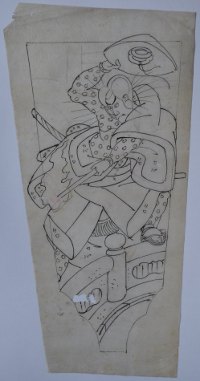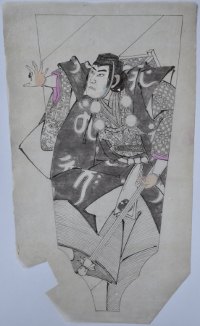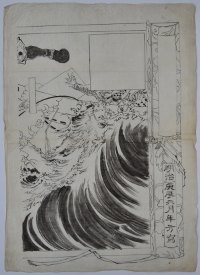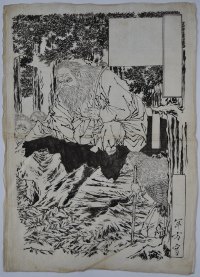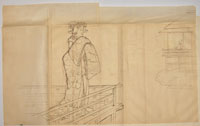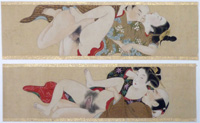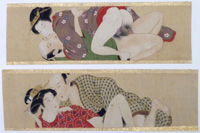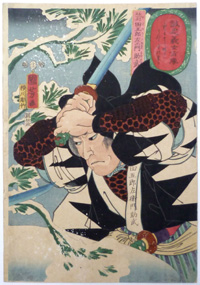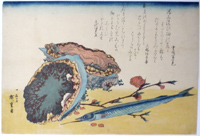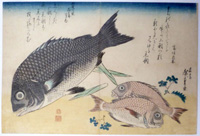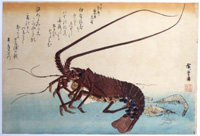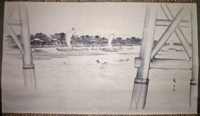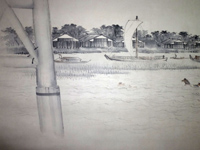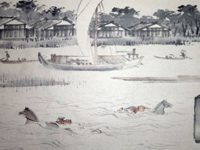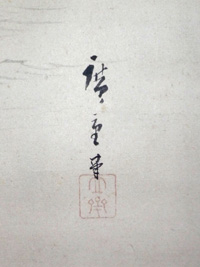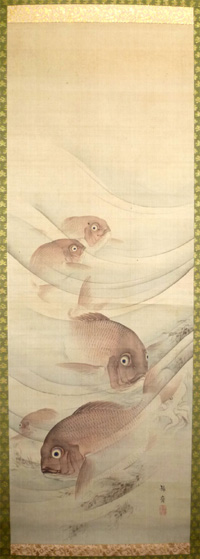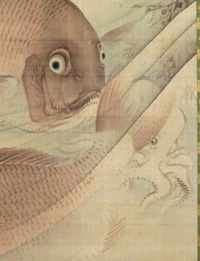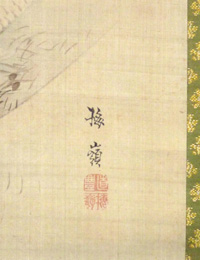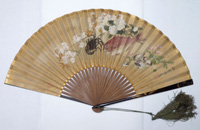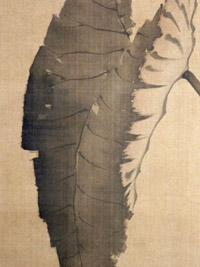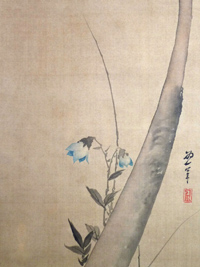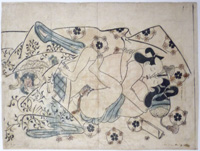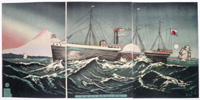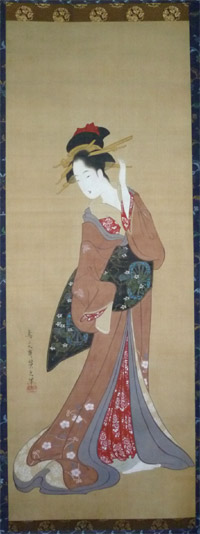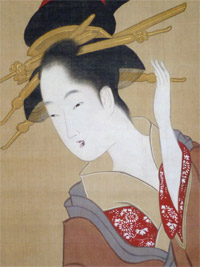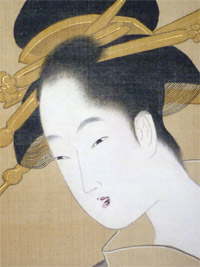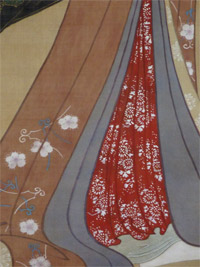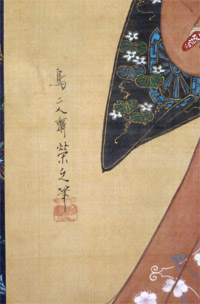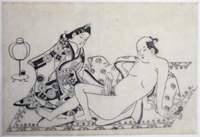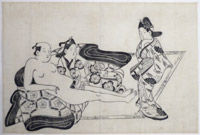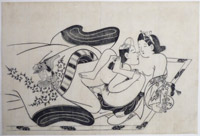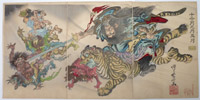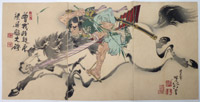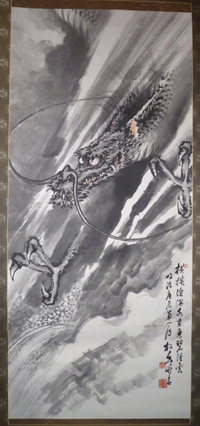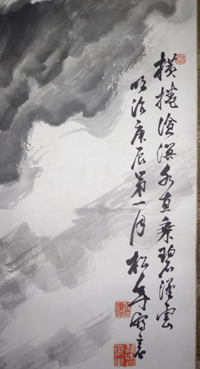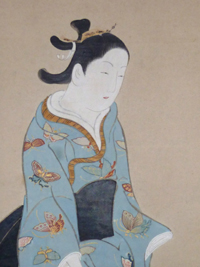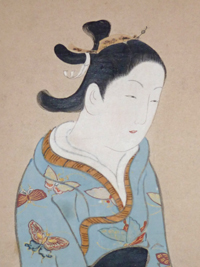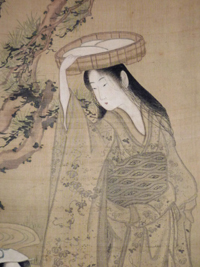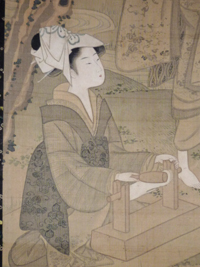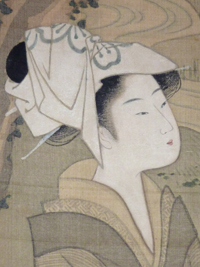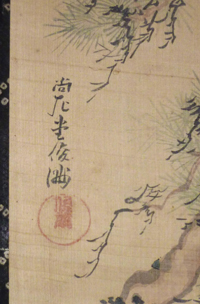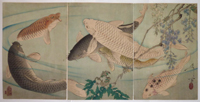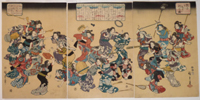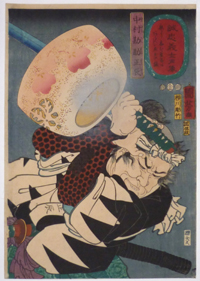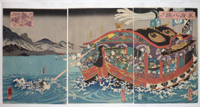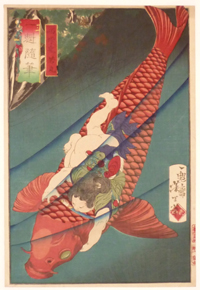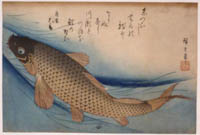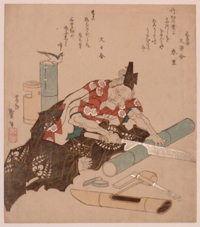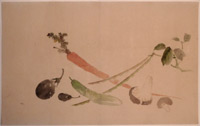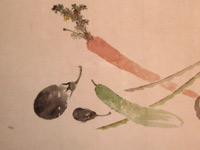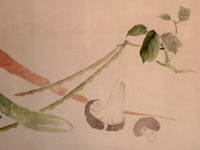/category/archive/page/30/
Toyohara KUNICHIKA (1835-1900)
Click here to view image full size.
An original hanshita-e drawing possibly showing Kagekiyo breaking prison. Sumi on thin paper. Image size 13 x 6.5 in, 33 x 16.5 cms. . For a series of designs contained within a hagoita ( wooden paddles used to play the New Year hanetsuki game ). Numerous indications for the printer for the colours to be used. One hole, otherwise good condition.
Status: Sold
Toyohara KUNICHIKA (1835-1900)
Click here to view image full size.
An original hanshita-e drawing probably showing Danjuro IX as Benkei. Sumi with light touches of pink and blue on thin paper, image size 12.75 x 6.5 in, 32.5 x 16.5 cms. For a series of designs contained within a hagoita ( wooden paddles used to play the New Year hanetsuki game ). In good condition.
Status: Sold
Mizuno TOSHIKATA (1866–1908)
Click here to view image full size.
A fine original drawing for the first sheet of a published triptych by Yoshitoshi for the set Dai Nippon shiryaku showing the naval battle of Dannoura in the reign of Antoku, the 80th Emperor. Published 20/4/1880. The British Museum has a complete preparatory sketch for this triptych. The drawing is signed “Copied by Toshikata” and is dated Meiji kano-e tatsu, 1880. Why Toshikata drew it is a puzzle: Possibly an exercise in preparation to making final drafts for the woodblock. Oban size. Sold as is with some creases. Provenance: From the atelier of Toshikata.
Status: Sold
Mizuno TOSHIKATA (1866–1908)
Click here to view image full size.
A fine original drawing for the first sheet of an unpublished ( ?) triptych by Yoshitoshi showing the king of the Tengu, Dai Sojobo, teaching martial arts to the young Yoshitsune. Drawn c 1880. The British Museum has a complete preparatory sketch for this triptych. The drawing is signed “Copied by Toshikata.” It has more detail than the BM example but why Toshikata drew it is a puzzle: Possibly an exercise in preparation to making final drafts for the woodblock. Oban size. Sold as is with some creases. Provenance: From the atelier of Toshikata.
Status: Sold
Ichiryusai HIROSHIGE (1797-1858)
S

Click here to view image full size.
An original drawing showing two beauties: One drying her hair, the other about to enter a mosquito net. Sumi on thin paper. 13 x 15.5 in., 33 x 40 cms.
Status: Sold
Ichiryusai HIROSHIGE (1797-1858)
Click here to view image full size.
A large original drawing showing a beauty on a balcony. In the distance another figure on another balcony. Possibly a study for a painting. Sumi and red under-drawing on thin paper. 15.25 x 25.5 in., 38.5 x 65 cms.
Status: Sold
Utagawa KUNIYOSHI (1797-1861)
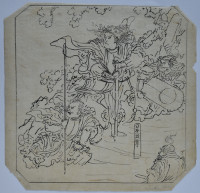
Click here to view image full size.
A fine original sumi drawing (hanshita-e) for an unpublished print for the set Tokaido gojusan tsui, “Fifty-three Parallels for the Tokaido Road.” The set was published by various publishers in 1845-6 and was a collaboration with Kunisada and Hiroshige. Sumi on thin paper. This is a design for the lower half of the oban print, the top half having the title and a panel with the name of the post-station. Shows Yamato Takeru no Mikoto. A legendary prince, son of the Emperor Keiko. Shown here with his retainers.
In extremely good condition. Provenance: Purchased from me in 21/11/1975. Rare.
Status: Available
Tsukioka SETTEI (1710-1786)
Four original paintings on silk. An artist who developed a style somewhere between Moronobu and Sukenobu. Well known for his elegant erotica painted with great refinement. Sizes vary from 3.25 in; 5.5 cms. x 12.75 in; 32.5 cms. to 3.25 in; 5.5 cms. x 11.5 in; 29 cms. Full colour and obviously taken from a hand scroll of 12 such paintings. Mounted onto gold-flecked paper. Unsigned.
Status: Sold
Utagawa KUNIYOSHI (1798-1861)
Click here to view image full size.
The ronin Yada Gorosaemon Suketake. A snow scene showing him facing an adversary with sword raised. From a fine set of twelve half length portraits of the forty-seven ronin: Seicho gishi shozo, “Portraits of Faithful Samurai of True Loyalty.” The depictions borrow strongly from western portraiture including imitation western script in the green border of the title cartouche. It is not necessary to repeat the story here as it is the best known Japanese tale. Published by Sumiyoshiya Masagoro, 12/1852.
Fine impression. Fine colour. Full size with extra paper left and top. Slight soil left margin, otherwise fine condition. Extensive splashed gofun to imitate snow. The printing on this set is exceptional with details such as the sword blades and title cartouches burnished. Signed Kuniyoshi ga.
Status: Sold
Ichiryusai HIROSHIGE (1797-1858)
Click here to view image full size.
Awabe or tokobushi, abalone or “sea-ear” ( Haliotus tuberculata ) and sayori, Japanese half-beak or snioe-fish ( Hemirhamphus sayori ), Together with peach blossom. Poems by Kumogaki Fujimi and Miwagaki Mimiki. From the first series of ten plus one prints published by Eijudo c. 1832-34. The set was issued privately for a poetry group ( probably the Shingyoku Circle ) with judges’ names and extra poems. These prints are of the utmost rarity as probably only enough for the Circle were printed and they never come onto the market. Extremely rare early state before the kiwame and large Eijudo seal. Kruml a/b
Fine impression, colour and condition. Signed Ichiyusai Hiroshige ga.
Status: Sold
Ichiryusai HIROSHIGE (1797-1858)
Click here to view image full size.
Kurodai, black sea bream ( Acantho pagus schlegeli ) and akadai, red bream ( Pagus tumifrons ) together with bamboo shoots and Japanese pepper. Poems by Tomigaki Uchiyasu and Kaoan Hoshi.. From the first series of ten plus one prints published by Eijudo c. 1832-34. The set was issued privately for a poetry group ( probably the Shingyoku Circle ) with judges’ names and extra poems. These prints are of the utmost rarity as probably only enough for the Circle were printed and they never come onto the market.
Fine, early impression before the grey block defect on the tail of the black sea bream. Full size. Kruml 10b. Signed Ichiyusai Hiroshige.
Status: Sold
Ichiryusai HIROSHIGE (1797-1858)
Click here to view image full size.
Ise-ebi, spiny lobster or crawfish ( family Panulirus ) and shiba-ebi, shrimps. Poems by Ryokujuen Motoari and Toshihiro Machikado. From the first series of ten plus one prints published by Eijudo c. 1832-34. The set was issued privately for a poetry group ( probably the Shingyoku Circle ) with judges’ names and extra poems. These prints are of the utmost rarity as probably only enough for the Circle were printed and they never come onto the market.
Very good impression and colour. Full size. Kruml 4c. Signed Hiroshige ga.
Status: Sold
Utagawa KUNIYOSHI (1798-1861)
Click here to view image full size.
A Chinese brigand ( Shinwa-Yi ? ) hanging onto a rock in a fast-flowing river. Above and below him other submerged protagonists. From an early set: Tsuzoku sangokushi yeiyu no ichi-ni, “Popular Heroes of the History of the Three Kingdoms.” Published c. 1837 by Joshuya Kinzo. Extremely rare: Not known to Robinson ( S.10 ) who only lists 8 prints ( including a key-block proof ) from this set. Possibly unrecorded.
Very fine impression, colour and condition ( proof state ). Full size with extra paper all round. Signed Cho-o-ro Kuniyoshi ga.
Status: Sold
Ichiryusai HIROSHIGE (1797-1858)
Click here to view image full size.
A large and important painting showing a view of the Sumida River through the piles of the Ryogoku Bridge. In the distance the ofunagura, “boat houses,” boats on the river and the Shogun’s official horses – goyouba – being taken out by samurai to the shoal outside the ofunagura-mae, the Shogun’s dock, to be cooled off. This masterpiece appears to be from a series of views of the Sumida as there is another – a view of Mimeguri, Sumida river bank in snow – in the Bato Hiroshige Museum of Art. The size, signature and seal is the same. Sumi and light colour on paper, 21.25 in; 54 cms. x 37 in; 94 cms. In very good condition. Old mount and box. Signed Hiroshige ga with Ichiryusai seal.
Status: Sold
Kono BAIREI (1844-1895)
Click here to view image full size.
A fine painter of kacho-ga and landscapes. Born and lived in Kyoto. Studied under Raisho and Bunrin. Especially well known for his teaching: In 1878 he began to work towards the establishment of an art school that opened in 1880 as the Kyoto Prefectural School of Painting. Contributed to numerous books from Bairei hyakucho gafu, 1881 to Bairei kacho gafu, 1881, Bairei hyakucho gafu zoku hen, 1884, Bairei gafu, 1886 et al. Shows a shoal of red sea bream, Pagrus major, and an octopus. Full colour on silk, 42.75 in; 108.5 cms. x 14 in; 35.5 cms. Probably original mount. Several small insect marks, otherwise very good condition. Signed Bairei with seals Naotoyo and Bairei.
Status: Sold
Taki KATEI (1830-1904)
A fine and decorative painted silk folding hand-fan by the Meiji artist Taki Katei. He lived in Tokyo and studied painting under Araki Kankai; also studied Chinese painting in Nagasaki. A fine kacho-ga painter. He contributed a lot to the medium of books and was the principle artist on three gafu: Kokotan gato, 1883; Kacho gafu, 1883 and Tanjo ippan, 1887. Shows a Japanese lobster, sea bream and shells with various flowers on one side and a hydrangea in a Chinese basket with various lilies on the other. The fan is in very good condition; the silk flecked with gold; the ribs are bamboo, the exterior decorated with floral designs in raised lacquer. The fan is contained within what is probably the original brocade case and has the original tassles. Fully open the fan measures 20.5 in; 52 cms. across and 11.25 in; 8.5 cms. in height. Fully signed and sealed on both sides Katei Taki.
Status: Sold
Katsushika HOKUSAI (1760-1849)
Click here to view image full size.
An important original painting showing a taro plant and balloon flowers. This statuesque plant is known as the village potato in Japan ( satoimo ) for its edible corms and “elephant ears” when grown ornamentally. Above is a poem by Ota Shokusanjin ( Ota Nampo ), a famous late Edo period poet and writer. The poem reads:
Aki chikoo saitsuru hanano koikaze ni
Kaburiwo fureru imoha arashina
Shokusanjin
Interestingly, Shokusanjin’s calligraphy is often at a slant. Why this should be I cannot say. The taro appears in other Hokusai paintings and there is another close version of this painting illustrated in the Special Exhibition, Hokusai, Nagoya City Museum, 1991.10.26 – 1991.11.24, no. 210. Hokusai often duplicated subjects as he was near to destitution many times. The painting employs the tarashi- komi – Rimpa technique of colours dripped or brushed into wet ink. Sumi and light colour on silk, 42.5 in; 108 cms x 11 in; 28 cms. Newly remounted and in fine condition with new box and futo-maki ( thick wooden roll to preserve the painting from damage ). Signed Iitsu hitsu with seal Iitsu. Sold together with what is probably the original box.
Status: Sold
Sugimura JIHEI (Fl. c. 1680-1698)
Click here to view image full size.
The most prolific of Moronobu’s pupils and was originally confused with him, but now properly identified as a separate artist. Produced some of the finest erotic designs. A couple in flagrante beneath a sumptuous duvet. Published c. mid 1680’s.
A large oban ( 11in; 27cms x 14.5in; 36.75cms ).
Good impression. Some restorations but generally good condition. Partially hand-coloured. Unsigned ( as usual ).
Status: Sold
Kobayashi KIYOCHIKA (1847-1915)
Click here to view image full size.
An extremely rare triptych: Sunshu Moho kokai chu no Fuji. Shows the paddle-steamer Daikokuya ploughing through the Sea of Miho, Suruga Province. The first rays of the sun hit the top of Mount Fuji. Kiyochika was an interesting artist: Although mainly self-taught, he also studied photography in Yokohama with Shimaoka Renjo and then the rudiments of western-style oil painting with the English correspondent, cartoonist, and painter Charles Wirgman. The influence of imported lithographs and etchings is evident in this print. Published by Matsuki Heikichi, 1878.
Very fine impression of the first edition with strong variegation in the sky, top left. Fine colour. Very slight trimming, otherwise very good condition. Signed Kobayashi Kiyochika hitsu.
Status: Sold
Hosoda EISHI (1756-1829)
Click here to view image full size.
A fine original painting by one of the best known Ukiyo-e artists. This high ranking individual produced some of the most refined prints during the late 1780s and the 1790s. He had many pupils including Eisho, Eiri and Eisui. Shows a standing beauty painted c. late 1790s. One hand adjusts a hairpin, while the other holds a partly concealed letter. Image size 35.25 x 13 in; 89.5 x 33 cms. Exquisitely painted in full colour on silk. In very good condition with futo-maki ( thick wooden roll to preserve the painting from damage ) and fine new mount and box. Signed Chobunsai Eishi hitsu with Eishi seal.
Status: Sold
Hishikawa MOROSHIGE (active c. 1684-1695)
Click here to view image full size.
A shunga print by the best of Moronobu’s direct pupils, who produced some of the finest designs in this genre. Shows a couple prior to coitus. Published c. mid 1680s.
Very good impression. Very slight soil and weakening along laid lines, but otherwise very good condition. Unsigned.
Status: Sold
Hishikawa MOROSHIGE (active c. 1684-1695)
Click here to view image full size.
A shunga print by the best of Moronobu’s direct pupils, who produced some of the finest designs in this genre. Shows a couple prior to coitus being approached by an attendant. Published c. mid 1680s.
Very good impression. Very slight soil and weakening along laid lines, but otherwise very good condition. Unsigned.
Status: Sold
Hishikawa MOROSHIGE (active c. 1684-1695)
Click here to view image full size.
A shunga print by the best of Moronobu’s direct pupils, who produced some of the finest designs in this genre. Shows a couple in flagrante aided by an attendant. Published c. mid 1680s.
Very good impression. Very slight soil and weakening along laid lines, but otherwise very good condition. Unsigned.
Status: Sold
Hishikawa MOROSHIGE (active c. 1684-1695)
Click here to view image full size.
A shunga print by the best of Moronobu’s direct pupils, who produced some of the finest designs in this genre. Shows a couple in flagrante, the huge duvet slipping off their bodies. Published c. mid 1680s.
Very good impression. Very slight soil and weakening along laid lines, but otherwise very good condition. Unsigned.
Status: Sold
Kawanabe KYOSAI (1831-1889)
Click here to view image full size.
MAY in romaji from a set of the twelve months, Junikagetsu no uchi, although this is the only known design for the set. One of Kyosai’s best designs. Shows Shoki, the “Demon Queller” riding a tiger and brandishing his two-edged sword at a group of terrified oni. Shoki ( Chinese: Chung K’wei ) was lauded for having relieved the Emperor Ming Hwang of the fever demon during his sleep. A favourite subject for Japanese artists, although mostly ignored by the Chinese. Published by Fukuda Kumajiro, 1887. Paintings of Shoki were hung on Boy’s Day ( 5th day of the 5th month ). Hence Kyosai choosing this subject for May.
Fine impression and colour. Very slight edge foxing, otherwise fine condition. This design is notorious for often being heavily trimmed and consequently for the three sheets not aligning properly. This example completely untrimmed with extra paper all round. Rare. Signed Kyosai ga.
Status: Sold
Taiso YOSHITOSHI (1839-1892)
Click here to view image full size.
Soga no Goro galloping at high speed, whipping the steed with a bamboo branch. He races to the aid of his brother in Oiso. This famous story tells how the brothers avenged the death of their father Sukeyasu by Suketsune who was under the protection of the shogun Yoritomo. The Soga brothers kill Suketsune but Juro is killed in the ensuing fight and Goro is subsequently beheaded. Published 1885 by Fukuda Yasushi. One of the great Yoshitoshi designs and rare.
Fine impression and colour. In exceptional condition. A design invariably trimmed whilst this impression has all margins intact. Signed Oju Yoshitoshi hitsu.
Status: Sold
Katsushika HOKUSAI (1760-1849)
Click here to view image full size.
The Aoigaoka [waterfall] in Edo: Toto Aoigaoka no taki from a set of eight prints with title, Shokoku taki meguri, “A Journey to the Waterfalls of All the Provinces.” A majestic set with a mostly beautiful unifying colour scheme: There is probably no other Hokusai set that has the same impact when viewed complete. Amongst Hokusai’s finest work and much sought after. There are numerous Hiroshige designs based on the same location but they are prosaic in comparison. Eisen, inspired by Hokusai, also produced a set of waterfalls in 1847 which are themselves fine and rare. This particular fall is in fact a spillway for the Tameike reservoir seen above. Aoi Hill near Toranomon Gate to the left. The set published by Eijudo, c. 1832. Rare.
Fine impression. Fine, unfaded colour. Minimal soil and slight trimming on left: These designs are martyrs to trimming and many illustrated examples are trimmed, otherwise very good condition. (This raises an interesting problem because most Hokusai landscapes do not have a black border – contrary to Hiroshige’s – which do, making it easy to judge the trimming on the latter.) Signed Zen Hokusai Iitsu hitsu.
Status: Sold
Suzuki SHONEN (1849-1918)
Click here to view image full size.
A large painting for the year of the Dragon 1880 ( Meiji 13 ). Suzuki Shonen was a major Kyoto-based Nihonga artist of the late Meiji period. The son of Suzuki Hyakunen, the founder of the Suzuki school of painting, whom he succeeded. He seems to have been a somewhat flamboyant character and was known as the “modern Soga Shohaku.” Shows the Dragon of the Storm descending above turbulent water. A mythological creature that dominated Chinese and Japanese art. It was a scaly four-legged serpent with dorsal spines, the head having two horns, long feelers, and flame-like streamers at the shoulders and hind quarters. Painted in sumi with light touches of red on paper. Image size 56 x 25 in; 143 x 64 cms. Newly mounted. Very good condition. Signed Suzuki Shonen with date seal.
Status: Sold
Okumura MASANOBU (1686-1764)
Click here to view image full size.
A newly discovered painting by one of the most influential artist in Ukiyo-e. His long life covered hand-coloured prints through to full colour printing in the mid 1760s and he was one of the first to use the block-printing process after 1740 and pioneer the benizuri-e picture. Extremely innovative: he pioneered the uki-e print, pillar prints and ishizuri-e. Not only was he a print artist, he also illustrated books, albums and produced paintings. He started his own publishing house, Okumuraya, which gave him greater control over the printing process. The popularity of his work led to many copies by other publishers, and he had to certify his work as “genuine.” Shows a standing beauty, Tachi bijin-zu. She carries a cherry branch and her gorgeous costume is decorated with grasses and flowers with cages for collecting insects and above various colourful butterflies. Full colour on paper, image size 35.75 x 12.25 in; 91 x 31 cms. Fine new mount with futo-maki ( thick wooden roll to preserve the painting from damage ) and box. Fine condition. Ex collection Raizou Kanda. Signed Hogetsudo Tanchosai Okumura Masanobu with seals Masanobu and Okumura. Although long lived, genuine paintings by him are rare.
Status: Sold
Kubo SHUMMAN (1757-1820)
Click here to view image full size.
A fine painting showing a seated girl fulling cloth ( a process of beating which eliminated the dirt and other impurities ) with another standing beauty holding beaten cloth in a wooden tray on her head. This scene represents Mishima, or Toi, Province of Settsu. One of the Six Crystal ( Tama ) Rivers. ( Toi is the alternative name of the river and the word for beating cloth. ) This was probably Shumman’s most celebrated subject. He produced a set of six prints on this theme published by Fushimiya Zenroku, c 1787. One of the most beautiful 18th century sets, and together with a night triptych showing people returning from a poetry reading, is considered his masterpiece. The prints and the known paintings of this subject use the benigirai style, “red avoiding” pioneered by Shumman, Eishi and Shuncho. Shumman, a man of great sophistication, designed only a few prints before concentrating on surimono and printing and issuing some of the finest in this format. ( See The Japanese Print A New Approach, J. Hillier, pp. 102-104: “Probably no artist except Choki has achieved so high a reputation on such a small number of prints.” ) He also excelled at painting, book illustration and light verse. Painted on silk in tones of sumi, very light green, gofun and a small touch of red on the girls’ lips. Image size: 36 x 12 in; 91.5 x 30.5 cms. Other versions of this subject are in the BM ( 1922.2-13.01 ) and the Freer Gallery of Art ( FI903.62 ), gift of Charles Freer. Painted c early 1790s. Slight loss of gofun and very minor spotting, but otherwise in very good condition. Interesting old mount. Exhibited in 1995 at Shunsen Museum in Nanamashi prefecture, Nikushitsu ukiyoe meisaku ten, hosted by Mr Keizaburou Yamaguchi, p. 40, no, 37. Painting guaranteed by Mr Narazaki, the box being signed and dated 1988 by him. Signed Shosado Shumman, with circular Shumman seal.
Status: Sold
Tsukioka YOSHITOSHI (1839-1892)
Click here to view image full size.
A triptych showing koi, “carp” swimming beneath hanging wisteria. One of Yoshitoshi’s finest and most popular designs. Published by Akiyama Buemon, 5/1889. See Beauty and Violence, Society for Japanese Arts, 1992, no. 66, p. 144 for another impression plus the original drawing by Yoshitoshi ( from the British Museum ). Also see this website in Brush Drawings and Hanshita-e for another two original drawings of koi by Yoshitoshi, possibly preliminary working ideas for the British Museum drawing. Yoshitoshi only produced one other carp print, a large surimono. Common carp were first bred for colour in Japan in the 1820s. Their name is a homophone for another word meaning “love” or “fidelity” and they are symbols of love and friendship in Japan.
Very fine impression and colour. Slight oxidation although not as much as is usually found on this design. Slight signs of mounting au verso, otherwise very good condition.
Status: Sold
Utagawa KUNIYOSHI (1797-1861)
Click here to view image full size.
The ronin Nakamura Kansuke Masatatsu dodging a brazier of hot ash. The best design from a fine set of twelve half length portraits of the forty-seven ronin: Seicho gishi shozo, “Portraits of Faithful Samurai of True Loyalty.” The depictions borrow strongly from western portraiture including imitation western script in the green border of the title cartouche. It is not necessary to repeat the story here as it is the best known Japanese tale. Published by Sumiyoshiya Masagoro, 12/1852.
Fine impression, colour and condition. Full size and the falling ash from the brazier represented by sprayed gofun ( slight loss ). The printing on this set is exceptional with details such as the sword blades and title cartouches burnished. Signed Kuniyoshi ga.
Status: Sold
Tsukioka YOSHITOSHI (1839-1892)
Click here to view image full size.
The ghost of Genta Yoshihira, having been executed by Taira no Kiyomori, springs into the air causing a thunderstorm and exacting revenge. The best design from Shingata sanjurokkaisen, “New Forms of Thirty-six Ghosts.” Published 1889 by Sasaki.
Very fine impression, colour and condition. The first edition. Signed Yoshitoshi.
Status: Sold
Utagawa KUNIYOSHI (1797-1861)
Click here to view image full size.
A triptych showing Koman, the widowed daughter of a Lake Biwa farmer, swimming with the white banner of the Genji in her teeth towards the Taira barge of Munemori. On being picked up and finding where she was she jumped overboard but not before Sanemori cut her arm off with the banner wrapped round it. For the full story see Pointers And Clues To The Subjects Of Chinese And Japanese Art, Sampson Low Marstone & Co. Ltd., Will Edmunds, 1934, p. 451. Published By Iseya Ichibei, 1846.
Very fine impression, colour and condition. Full size. Signed Ichiyusai Kuniyoshi ga.
Status: Sold
Utagawa KUNIYOSHI (1797-1861)
Click here to view image full size.
A triptych showing Raiko attacking the Shuten-doji. A well know myth covered by numerous artists of all periods. Shuten-doji, “Great Drunken Boy” had great strength and atrocious habits, plundering the countryside around his stronghold on Oyeyama, “Devil’s Mountain.” The Emperor Murakami, losing patience, ordered Raiko to put an end to his exploits with the aid of a magic cap and poisoned sake. Raiko and his main retainers: Sakata no Kintoki, Usui no Sadamitsu, Watanabe no Tsuna, and Urabe no Suyetake stupefied the enormous hulk that was Shuten-doji and decapitated him. Depictions of this scene usually show the head flying through the air and it often has a more gruesome appearance with fangs and horns. Raiko returned in triumph with the head to Kyoto. One of Kuniyoshi’s best designs. Published c 1851-2 by Amatsu. Robinson T261. Rare.
Fine impression and colour. Some oxidation as usual. Slight trimmimg, otherwise very good condition. Signed Ichiyusai Kuniyoshi ga.
Status: Sold
Tsukioka YOSHITOSHI (1839-1892)
Click here to view image full size.
Saito Oniwakamaru, “Young Devil Child” ( Benkei ) fighting the giant carp in the waterfall of Bishamon ga taki. The best design from a fine set: Ikkai zuihitsu, “Essays by Yoshitoshi.” A set of 13 prints published by Masadaya in 1872. There are numerous variations in seals in this fine set but, as yet, no research has been done into their significance. However, this appears to be the first edition. There are versions with publisher’s seals right margin in red and in black and missing altogether. The earliest impressions, as here, have no gradation below the top two currents. Also, the slightly later editions use stronger aniline colours. One of Yoshitoshi’s great designs.
Fine impression with strong woodgrain. Fine colour. Retains original album backing. Slight trimming top margin. Signed Ikkaisai Yoshitoshi hitsu.
Status: Sold
Ichiryusai HIROSHIGE (1797-1858)
Click here to view image full size.
Koi, carp ( Cyprinus carpio ), swimming amongst reeds. Poem by Makuzu. From the second series of ten fish prints published by Yamasho, c 1840-42. The first series was issued privately for a poetry group ( probably the Shingyoku Cicle ) with judges’ names and extra poems. These prints are of the utmost rarity as probably only enough for the Cirle were made and they never come onto the market. Due to their popularity this second set was commissioned.This is the very rare first edition with the reeds printed. Block defect showing but with gradation still on belly. One of the finest designs from the two series. Very rare. Kruml 12a/b.
Fine impression. Very slight fading and thinning, oltherwise very good condition. Full size and without centre fold ( in itself rare as they invariably have them ). Signed Hiroshige hitsu.
Status: Sold
Katsushika HOKUSAI (1760-1849)
Click here to view image full size.
A surimono showing a bamboo-ware maker. One of the characters from Taketori monogatari, “Tale of the Shining Princess.” He is shown sawing through a large bamboo stem surrounded by his tools. Behind him an uguisu ( bush warbler, signifying the arrival of spring ) sits on a bamboo vase. Two poems above by Bunyusha Harusato and Bunbunsha. Provenance: From my Surimono Prints catalogue, no. 15, 1975, no. 6.
Very fine impression. Fine colour. The saw blade, chisel and other areas printed in silver. The outline of the craftsman’s trousers printed in gold. Very good condition. Signed Katsushika Taito ( signature of c 1819 ).
Status: Sold
Katsushika HOKUSAI (1760-1849)
Click here to view image full size.
A wonderfully delicate study using light washes showing a Japanese carrot, mushrooms, a Japanese cucumber ( which have knobbles or spikes as opposed to our smooth-skinned varieties ), aubergines and long beans ( possibly yardlong beans ). Obviously from a large album of such studies ( it has a light centre fold ) which would have been signed and/or sealed at the end.
Full colour on paper. Fine condition. 11.5 x 18.5 in; 29.5 x 47 cms.
Status: Sold
